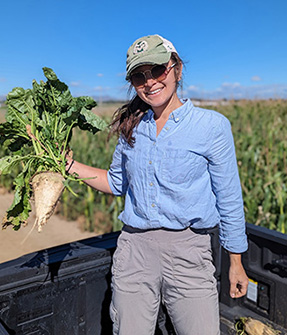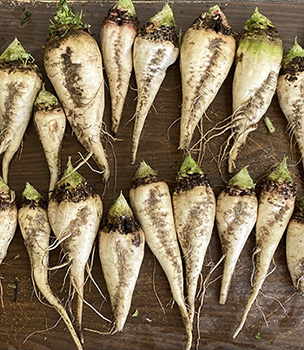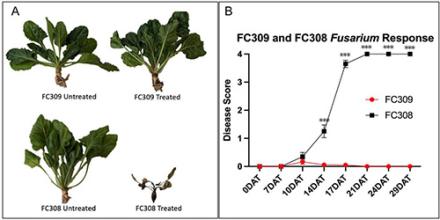ARS Develops New Disease-Resistance Traits for Sugarbeets

Biological Science Aid Elizabeth Hada in a sugarbeet field at Ft. Collins, CO. (Photo by Olivia Todd, ARS).
Agricultural Research Service (ARS) scientists have bred new disease-resistant sugarbeet lines using cutting-edge genome mapping technologies. By adapting these new genomic lines and genomic tools, plant breeders are now able to greatly improve the sugarbeet’s tolerance to disease.
Fusarium Yellows is one of many fungal diseases that can result in extensive damage to the sugarbeet crop yield. The soil-borne fungus triggers wilting, yellowing, loss of leaves and a plant’s death. In 2023, Fusarium caused over $31 million dollars in economic losses for U.S. sugarbeet farmers, according to Kevin Dorn, a geneticist at the Soil Management and Sugarbeet Research Unit in Fort Collins, CO.
“Improving genetic resistance to disease has been the focus of ARS sugarbeet research for decades,” Dorn said.
More than half of all sugar produced in the United States is from sugarbeets, which grow on over one million acres. The largest share of sugarbeets is produced in the Red River Valley, located throughout areas of Minnesota and North Dakota.
ARS’ development of new genetic sugarbeet lines could curb Fusarium and other diseases, resulting in a more productive crop. This insight is part of a larger effort by ARS researchers to continually improve its breeding efforts through genome analysis.
In May 2024, ARS researchers published the results of their most recent genome research.

A pile of recently harvested sugarbeets (Photo by Kevin Dorn, ARS).
“The key point of this paper is that we used this advanced DNA sequencing technology to create the most complete map of the sugarbeet genome to date,” said Dorn. “We also adopted that new map to identify the genomic location of the Fusarium resistance trait. In addition, we utilized a sequencing technology called ‘RNA sequencing,’ to pinpoint the individual genes likely responsible for the resistance.
“DNA sequencing technology is really amplifying the impact of our research programs,” he added.
The ARS team’s use of genomic analysis of new resistant lines is providing essential tools for public and private sugarbeet breeders.
“Here is a resistance trait that breeders can immediately transfer into commercial lines,” Dorn said. “Normally, it would take years to evaluate a new line and introduce it into a breeding program. Additionally, this research allows us to further develop molecular markers. That will enable commercial breeders to more quickly identify whether what we have discovered in our lab is a new resistant trait that does not already exist in their breeding programs,” he said.
Dorn expects further discoveries through DNA analysis will create more efficiencies in breeding sugarbeets and other crops.
“This is really going to speed up our research programs … to the point that ARS-developed traits will be more quickly available for farmers to plant in their fields,” he said.

In January 2024, the ARS team’s initial findings, (and image right) were published in the Journal of Plant Registrations, Volume 18, Issue 1. – Tami Terella-Faram, ARS Office of Communications
You May Also Like:

